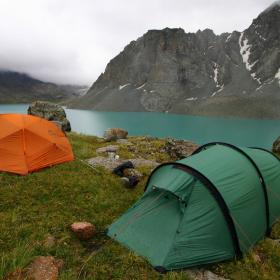What’s on the Menu in Kyrgyzstan?

People all over the world travel to different countries to gain new experiences. Some people prefer exploring nature, going on adventures, learning about different cultures, or simply relaxing somewhere away from the chaos of everyday life. As for me, one thing I love about traveling in particular is the opportunity to try all different kinds of food. If you’re traveling to Kyrgyzstan, you’ll find that Kyrgyz cuisine is definitely one of a kind.
In Kyrgyzstan, meat and dairy products are an integral part of national dishes because of the country’s nomadic heritage and easy access to these products. Lamb, beef, and horse meat are the most common meat types along with fresh horse, cow, and goat milk which are made into a variety of different dairy products that you’ll find all over the country. Grains, starches, and steaming pots of tea also usually supplement each meal. An added bonus is that meat, fruits, and vegetables within the country are fresh and organic; people in Kyrgyzstan prefer avoiding the use of chemicals and additives.
Kyrgyzstan has several traditional dishes that have been refined and perfected over time. As with most countries, it has also adopted several dishes from neighboring countries that add to the country’s repertoire of food.
Some traditional Kyrgyz dishes include Oromo, BeshBarmak, Borsok, Kuurdak, and Kazy Karta.
Oromo is my favorite dish in Kyrgyzstan. Oromo is layers of thinly rolled dough stuffed with meat, fat, and a variety of vegetables of the chef’s choice: carrots, onion, potato, or pumpkin. Then the whole thing is steamed. It’s often eaten with a spicy red sauce or even ketchup. While this can be found in some restaurants, it’s more common to find it made in households.
BeshBarmak is Kyrgyzstan’s signature nomadic dish made with freshly cooked meat shaved into little piecesand then poured over a pile of steaming noodles, onions, and sauce/broth. Name of it is actually a manual instruction, because it means “Five fingers”. Furthermore, you can still encounter people, that eat it with bare hands. If you got a chance to visit “toi” (family or commons celebration) you may not be served with conventional cuntlery, so be prepared.
Manty is made by rolling out small circles of dough, stuffing them with meat, fat, and onions, and pinching the dough together at the top to enclose the filling. They’re little pockets of goodness! Regular manty is steamed. If you think that any food is best when its fried, like me, you can also order fried manty. Also you can find places where they are made fully from vegetables and suitable for vegetarians.
Lagman is noodles, meat, and various vegetables (onions, peppers, etc.) served in a broth. Boso-Lagman is the same thing minus the broth and everything is then fried. Boso-lagman makes a great, filling, wintertime meal. Lagman noodles origins are one of the most fascinating in this list. Kyrgyz women can make them without using a knife, imagine that! They simple prepare the dough and then twist it and whirl and pull it into separate noodles and make sure that each one of them is moderately sized. However, if you try to make it yourself you will find it incredibly difficult, it requires a lot of practical experience for making perfect noodles. It is a time-consuming process and nowadays it is not common and you can find pre-made noodles in shops and markets, along with special noodle-cutting machine. However, on special occasions or in some places you may find lagman, that was made in traditional way and if you like that dish, you can spot the difference.
Plov (pilaf) is fried carrots and onions cooked in with rice and spices, then topped with chunks of meat. It’s a staple in Kyrgyzstan cuisine and often served on special occasions. Practicality of that meal is notable, you can cook either a small portion, or make an enormous amount of it in special kazan (Kyrgyz cast iron cooking pot), that could be enough for hundred people!
Samsy is the ultimate Kyrgyz fast food. No, no, not the way you think. Samsy are pockets of dough stuffed with meat, onions, and fat cooked in a tandoor usually with sesame seeds baked onto the top. When you’re traveling around Kyrgyzstan, it’s common to see vendors with tandoors selling samsy. It’s easy to just grab 1-2 and go. They’re a great quick, tasty snack on the road.
Ashlyam-Fu is a spicy soup of meat, vegetables, and noodles that is served cold. Interesting fact that it served along with rice crystallized starch, that has no taste, but may be somewhat disturbing for some people. Most people I’ve met either love this dish or hate it the first time they try it. Which one are you?
These aren’t the only foods available in Kyrgyzstan by any means, but ones that you’ll most likely see available all around the country. For people interested in learning how to make some traditional foods, there are also cooking classes available in Bishkek if you’re looking for a more hands-on approach. Either way, don’t limit yourself to trying just 1 or 2 dishes while you’re in Kyrgyzstan; give your taste buds an adventure and try something new!

















